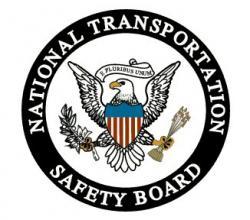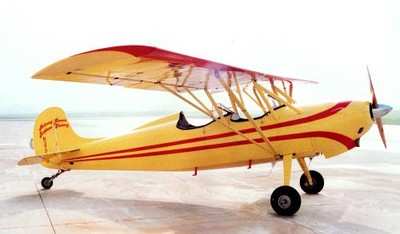FAA Looking For Another Aircraft That May Have Been In
Collision
 Ouch... here's a
fascinating, but curious, NTSB prelim... one in which there seems
to be some question as to why an experimental Bakeng Duce (a really
lovely airplane with some excellent handling qualities) came apart
and impacted the ground near Ramona CA, with fatal results for the
two aboard. Christopher Kloman (50), and Paul Franklin Claerbout
(60), of Ramona, were killed May 9th when their aircraft was seen
to have shed a portion of a wing and impacted the ground after an
uncontrolled descent. A five foot section of the right wing was
found a quarter mile away from the rest of the wreckage. Initial
reports called it an in-flight breakup... but this recent NTSB
Prelim shows that this isn't necessarily the cause...
Ouch... here's a
fascinating, but curious, NTSB prelim... one in which there seems
to be some question as to why an experimental Bakeng Duce (a really
lovely airplane with some excellent handling qualities) came apart
and impacted the ground near Ramona CA, with fatal results for the
two aboard. Christopher Kloman (50), and Paul Franklin Claerbout
(60), of Ramona, were killed May 9th when their aircraft was seen
to have shed a portion of a wing and impacted the ground after an
uncontrolled descent. A five foot section of the right wing was
found a quarter mile away from the rest of the wreckage. Initial
reports called it an in-flight breakup... but this recent NTSB
Prelim shows that this isn't necessarily the cause...
Update: A post to a Bakeng Deuce forum reports
that a Deuce pilot was asked to look at photos of parts of the
wreck to ID paint found on wing components, by the FAA. He reports
that pictures show "blotchy white
smears," that the FAA reported to have looked like paint,
and should not have been located where they were observed.
Curiouser and curiouser...
NTSB Identification: WPR09FA234
14 CFR Part 91: General Aviation
Accident occurred Saturday, May 09, 2009 in Ramona, CA
Aircraft: Upton Bakeng Duce, registration: N86YP
Injuries: 2 Fatal.
This is preliminary information, subject to change, and may
contain errors. Any errors in this report will be corrected when
the final report has been completed.
On May 9, 2009, about 1435, an Upton Bakeng Duce (file photo
shown below), N86YP, impacted the ground about 6.4 miles
east-southeast of Ramona, California. The amateur built, single
engine, experimental airplane was operated by the pilot, who had
borrowed the airplane from its owner. The pilot held a private
pilot certificate. A second pilot was also on board, and he held a
commercial pilot certificate. The airplane was destroyed during its
uncontrolled descent and ground impact. There was no fire. Both
pilots were killed during the personal flight. Visual
meteorological conditions prevailed at the time, and no flight plan
had been filed. The Upton's flight was performed under the
provisions of 14 Code of Federal Regulations Part 91, and it
originated from the Ramona airport about 1423.
Federal Aviation Administration (FAA) and National
Transportation Safety Board personnel interviewed a total of nine
persons who reported observing and/or hearing an accident. One of
these witnesses reported to the Safety Board investigator that,
from her vantage point on elevated terrain in a hilly area, she had
observed two airplanes flying in close proximity to each other for
at least several seconds prior to their colliding. None of the
other witnesses (all in different locations) reported observing a
second airplane in the vicinity. One of these witnesses reported
observing the accident airplane for a period of time prior to the
crash, but described his observations as having been
intermittent.

According to the hilltop eyewitness, one of the airplanes was
flying slower than the other airplane. The faster moving airplane
was predominately white in color, and the slower moving airplane
was predominately colored red. The witness further reported to the
Safety Board investigator that she observed the airplanes
maneuvering "dangerously" close to each other. The witness stated
that during the time she observed these airplanes, the red airplane
appeared to make relatively shallow turns as compared with the
maneuvers that the white airplane performed. The witness reported
that a midair collision occurred while the red airplane was flying
in an easterly direction, and the unidentified airplane was
climbing in a northerly direction.
 The eyewitness
reported that, immediately following the collision, the red
airplane rolled into a 90-degree bank, a span of wing appeared to
break off, and the airplane spiraled downward until impacting the
ground. Following the impact, she did not recall seeing the faster
airplane again.
The eyewitness
reported that, immediately following the collision, the red
airplane rolled into a 90-degree bank, a span of wing appeared to
break off, and the airplane spiraled downward until impacting the
ground. Following the impact, she did not recall seeing the faster
airplane again.
The Upton Bakeng Duce's wreckage has been recovered from the
accident site. The outboard 5-foot-long span of the airplane's
right wing was located about 1/4-mile from the main wreckage. The
airplane's right wing main and aft spars were found fractured in
multiple locations, about mid-span. Spar fragments have been
collected for follow-up examination.
The Safety Board is continuing to investigate the presence and
involvement of a second (unidentified) airplane in the reported
midair collision.
 Airborne 07.21.25: Nighthawk!, Hartzell Expands, Deltahawk 350HP!
Airborne 07.21.25: Nighthawk!, Hartzell Expands, Deltahawk 350HP! ANN's Daily Aero-Term (07.27.25): Estimated (EST)
ANN's Daily Aero-Term (07.27.25): Estimated (EST) ANN's Daily Aero-Linx (07.27.25)
ANN's Daily Aero-Linx (07.27.25) NTSB Final Report: Luce Buttercup
NTSB Final Report: Luce Buttercup Classic Aero-TV: 'That's All Brother'-Restoring a True Piece of Military History
Classic Aero-TV: 'That's All Brother'-Restoring a True Piece of Military History





